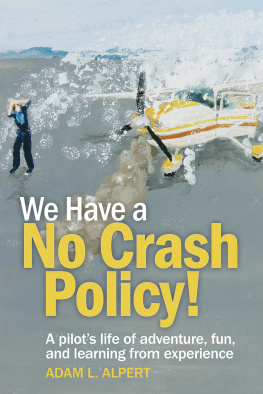Robert Schapiro - Secrets from the Cockpit: Pilots Behaving Badly and other Flying Stories
Here you can read online Robert Schapiro - Secrets from the Cockpit: Pilots Behaving Badly and other Flying Stories full text of the book (entire story) in english for free. Download pdf and epub, get meaning, cover and reviews about this ebook. genre: Non-fiction. Description of the work, (preface) as well as reviews are available. Best literature library LitArk.com created for fans of good reading and offers a wide selection of genres:
Romance novel
Science fiction
Adventure
Detective
Science
History
Home and family
Prose
Art
Politics
Computer
Non-fiction
Religion
Business
Children
Humor
Choose a favorite category and find really read worthwhile books. Enjoy immersion in the world of imagination, feel the emotions of the characters or learn something new for yourself, make an fascinating discovery.
- Book:Secrets from the Cockpit: Pilots Behaving Badly and other Flying Stories
- Author:
- Genre:
- Rating:3 / 5
- Favourites:Add to favourites
- Your mark:
- 60
- 1
- 2
- 3
- 4
- 5
Secrets from the Cockpit: Pilots Behaving Badly and other Flying Stories: summary, description and annotation
We offer to read an annotation, description, summary or preface (depends on what the author of the book "Secrets from the Cockpit: Pilots Behaving Badly and other Flying Stories" wrote himself). If you haven't found the necessary information about the book — write in the comments, we will try to find it.
Robert Schapiro: author's other books
Who wrote Secrets from the Cockpit: Pilots Behaving Badly and other Flying Stories? Find out the surname, the name of the author of the book and a list of all author's works by series.
Secrets from the Cockpit: Pilots Behaving Badly and other Flying Stories — read online for free the complete book (whole text) full work
Below is the text of the book, divided by pages. System saving the place of the last page read, allows you to conveniently read the book "Secrets from the Cockpit: Pilots Behaving Badly and other Flying Stories" online for free, without having to search again every time where you left off. Put a bookmark, and you can go to the page where you finished reading at any time.
Font size:
Interval:
Bookmark:

SECRETS FROM
THE COCKPIT
Pilots behaving badly and
other flying stories
ROBERT SCHAPIRO
JONATHAN BALL PUBLISHERS
Johannesburg Cape Town London
Tom Grunnick: What do you do when your
real life exceeds your dreams?
Exchange between a successful TV anchor and an unsuccessful writer in the 1987 movie Broadcast News
Good advice, but Im not going to follow it. Im going to spill the beans on how the most unlikely person, me, became one of just a few thousand people in the world to end up in the command seat of a Boeing 747 captain of a jumbo jet.
My career had its costs. I missed many important milestones in my son Morgans life. I tried to make up for it by bringing back gifts from every trip, but soon feared that was all he was waiting for when I returned home jet-lagged, tired and irritable my bag with the goodies inside. I didnt get to make some of the important decisions in his life my wife, Arlene, did that and I quickly learned it was wrong to come home, interfere and then leave again.
But Morgan always loved my flying stories. He still does, even though hes not a child any more. Hell laugh and say, Dad, youve got to write that one down sometime. Some years after I retired I did just that. To my amazement, I covered page after page of a legal pad and those were just the chapter headings.
This book is a time capsule of the military and civilian aviation industry between 1975 and 2010, particularly in apartheid South Africa and in Japan. Im not trying to criticise anyone, Im just trying to tell readers my flying stories exactly as they happened or, in cases that were too good to miss, as they were told directly to me by other pilots.
I hope you enjoy reading these stories as much as I enjoyed writing them.
Robert Schapiro
Editors note:
Secrets from the Cockpit follows the widespread international aviation practice of using the imperial system to measure altitude, speed and distance. Fuel is typically ordered in gallons. For readers interested in metric equivalents, a foot is roughly equal to 30 centimetres, a mile is 1.6 kilometres, a knot/nautical mile is 1.8 kilometres, a pound is just shy of half a kilo and a gallon is around four litres.
AGA Aerodrome Ground Aid (homing beacon)
AGL above ground level
ATC air traffic control
ATIS Automated Terminal Information System
auto-throttle automatically moves the thrust levers
CRM Crew Resource Management
DME distance measuring equipment
downwind flying outbound, parallel to landing runway
drag retarding force/friction
engine stall disruption of airflow through engine
feathering setting propellor blades into the windstream
flaps movable surface on rear of main wing to increase lift
flare raise aircraft nose to soften touchdown
finals (final approach) last portion of an approach
hold circle over a fixed point
HF high frequency, long-range radio
IAS indicated air speed
idle thrust minimum thrust, thrust levers closed
ILS Instrument landing system (provides electronic guidance to touchdown point)
IMC Instrument Meteorological Conditions
instrument flying using only flight instruments, no visual references
INS inertial navigation system
markers touchdown zone markers
reverse thrust redirecting engine exhaust gas forward to slow aircraft on runway
sideslip high-drag yawing manoeuvre to lose height quickly
sink rate rate of descent, generally feet/minute
speed brake rising panels on top of main wings
STAR Standard Terminal Approach Route
RA resolution advisory
TCAS Traffic Alert and Collision Avoidance System
TOC top of climb
TOD top of descent
VAs Vital Actions
VHF Very High Frequency, short-range radio
visual approach approach using visual references
VOR VHF omnidirectional radio beacon
wake turbulence rough air behind an aircraft
windmilling revolving propeller not powered by engine
wind shear rapid variations in wind speed and direction
It was a regular flight from Amsterdam to Anchorage. Until the fire alarm started blaring.
Wed left the Netherlands on a rainy summer afternoon, planning to fly our Nippon Cargo Airlines jumbo jet via Norway and the North Pole to Alaska. Id climbed to our initial cruise altitude of 29 000 feet, changed from my uniform into my sweats, made myself tea and was resting my feet on the instrument panel footrests while I watched the Norwegian fjords slowly receding under our right wing. Then came that bell.
The flight engineer turned off the jarring noise. We scanned the engines. All four looked fine. Where the hell is that? asked our captain, a former Trans World Airlines (TWA) pilot best known in the airline for a Mississippi accent so thick even fellow Americans had problems following him.
Main Deck Cargo, replied the flight engineer, in a clipped, disbelieving voice.
Get the checklist, said the captain.
The checklist, a thick book known as the QRH, or Quick Reference Handbook, provides step-by-step procedures for in-flight malfunctions and emergencies. In this case, there was a simple bottom line: Land at nearest suitable airport.
An onboard fire is one of the most dangerous things that can happen on an aircraft. Its almost impossible to control in the air, so the only response is to get on the ground fast and get the hell out. I already had painful knowledge of what could happen to a burning 747. In 1987, when I was a pilot for South African Airways (SAA), a fire in the cargo hold of an SAA plane called the Helderberg caused the aircraft to break up just off the Indian Ocean island of Mauritius. It plummeted into the sea a little more than 20 minutes away from landing, killing all 159 people on board.
Captain Mississippi radioed Norwegian air traffic control (ATC) with just one question: Where is the nearest airport capable of landing a Boeing 747?
Bergen, came the startled reply. About 180 nm (nautical miles) ESE of your position. The captain requested immediate clearance to descend from 29 000 feet and to head for Bergen, saying that we had a possible onboard fire. Are you declaring an emergency, Nippon? asked the controller, a procedure that would give us priority over all other traffic. Hell, yes. Yes we were. Proceed as requested and descend to 5 000 feet at your own discretion, he said, giving us a magnetic heading to Bergen and the frequency of the airports VHF omnidirectional radio (VOR) beacon.
I hadnt waited for the exchange to end before swinging the nose to the right, aided by a healthy push of the right rudder to speed the turn. As soon as I was pointing in roughly the correct direction, I closed the throttle and pulled the speed brake. Down we went with our speed at the safest maximum known in aviation as being on the clackers because of the system that makes a loud clacking noise if you go too fast.
Should we dump fuel? asked the flight engineer. It wasnt really a question: we were at least 100 000 pounds (45 000 kilograms) overweight for landing. Yes, do it immediately, said the captain.
Within moments, two thick streams of fuel were pouring from the fuel jettison nozzles on the wingtips. We were now fully committed to the unscheduled landing.
Rob, why are you descending so early? the captain asked as we passed 20 000 feet. At this rate, well be at 5 000 feet at least 80 miles before Bergen.
With the Helderberg in my mind, Id wanted to be in a position to get our plane on the water quickly if it became necessary. To placate him, I stowed the speed brake and put on a little power to flatten the descent. Then we turned to our next urgent problem. We were heading full speed towards an airport for which we had zero knowledge or information.
Next pageFont size:
Interval:
Bookmark:
Similar books «Secrets from the Cockpit: Pilots Behaving Badly and other Flying Stories»
Look at similar books to Secrets from the Cockpit: Pilots Behaving Badly and other Flying Stories. We have selected literature similar in name and meaning in the hope of providing readers with more options to find new, interesting, not yet read works.
Discussion, reviews of the book Secrets from the Cockpit: Pilots Behaving Badly and other Flying Stories and just readers' own opinions. Leave your comments, write what you think about the work, its meaning or the main characters. Specify what exactly you liked and what you didn't like, and why you think so.










